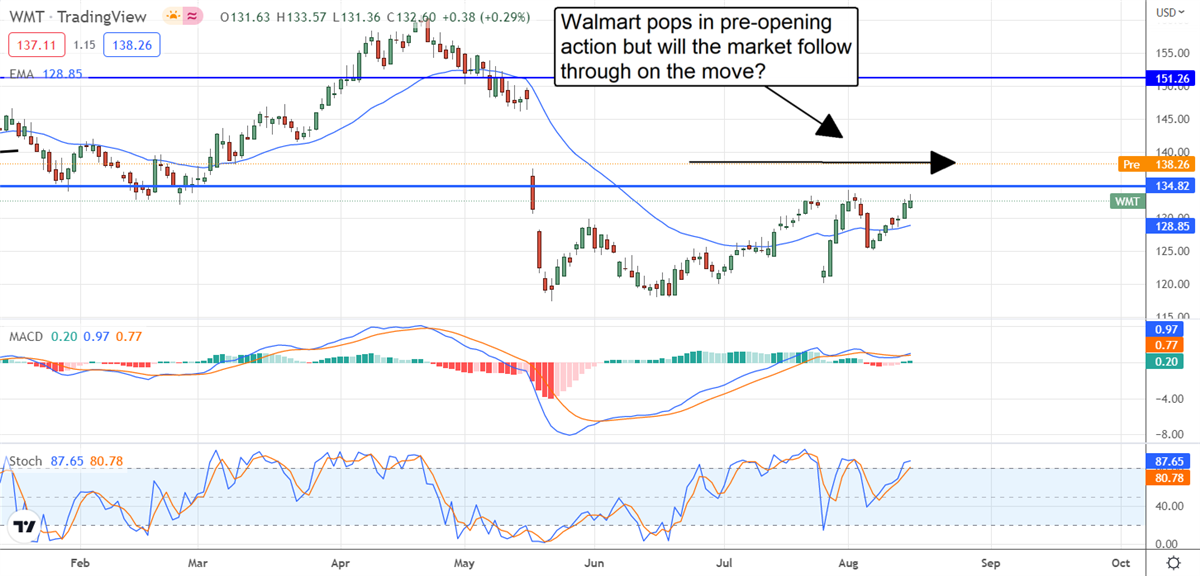
Walmart (NYSE: WMT) issued a far-better-than-expected Q2 earnings report and shares are moving higher in the wake of it. The move has the stock up nearly 5% in premarket trading and above a previous resistance target where upward momentum could build. The question is if the market will follow through on the move and, more importantly, if other retailers with issue similar reports because there is still risk in the market. Walmart issued better-than-expected results and raised the guidance but to a range in-line with the consensus which means much of the year’s strength has been seen and future quarters could be weaker than expected. Competitors like Target (NYSE: TGT) report this week as well so there could be volatility ahead regardless of the ultimate direction of the market.
Walmart Moves Up On Strong Results, Iffy Guidance
Walmart had a strong quarter and is on track to grow this year but there is a problem for the market in regards to the consensus figures. The company reported $152.6 billion in net revenue for a gain of 8.2% over last year which beat the consensus but by a slim 175 basis points which is below the market average. The good news is that comps are up in all segments and double-digits in the two-year stack with notable strength in Sam’s Club segment. Sam’s Club sales led the group with a 9.5% comp this year which equates to a 17% gain in the two-year stack. The strength was driven by an 8.9% increase in membership revenue that has member count at an all-time high as shoppers target the value stores. This is important because it could mean strength for names like Costco (NYSE: COST) when it reports next month and BJ’s Wholesale Club (NYSE: BJ) when it reports later this week.
A margin improvement was logged as well but there is an offsetting factor that robs the results of some shine. At the gross level, profit fell 132 basis points due to markdowns and mix and investors should expect these pressures to continue if not increase while at the operating level profit fell by 6.8% versus the 8.2% gain in revenue. The worse news is that the operating margin would have contracted more if not for the positive influence of an insurance settlement but the earnings are still better than expected. The company reported $1.77 in adjusted earnings which includes a $0.05 impact from the insurance settlement and beat the consensus by $0.17 or about 10%. The takeaway here is that adjusted EPS x-settlement money is still $0.12 ahead of consensus which is about 7.5% and better than the broad market average.
The iffy news and the factor that may keep Walmart moving sideways rather than up is the guidance. The company raised the guidance because of the 2nd quarter strength and current conditions but to a range that is more in line with the consensus than not. The Q3 revenue is expected to grow 5% YOY versus the 3.85% consensus but EPS will contract -9% to -11% versus the -11% consensus which suggests margin pressures are increasing. The full-year guidance is just as mixed with the revenue target of 4.5% slightly below consensus and the EPS range of -8% to -10% better than the -11% consensus but still bad news in regard to margin.
Walmart Is Expensive For What You Get
Shares of Walmart are expensive trading at 24X this year’s earnings, especially in light of its relatively low yield. The stock pays about 1.65% which is above the broad market average and a safe payout but low compared to some others in the retail sector. Close competitor Target pays a slightly higher 2.0% yield while trading at only 20X and there are even better value/yield combinations when you broaden the search. Footlocker (NYSE: FL), for one, has a stable business and cash flow and pays more than 4.4% while trading at only 7X its earnings.
Turning to the chart, shares of Walmart are up nearly 5.0% in premarket trading and above the $135 level but this market is not out of the weeds yet. There is still significant resistance at or near the top of the recent trading range and within the open window that formed when the company issued its profit warning last spring. Even if the market is able to hold the current levels and move higher there is a risk the gains will be capped somewhere within the range up to the top of the range near $150 and move back to retest the recent lows. 






